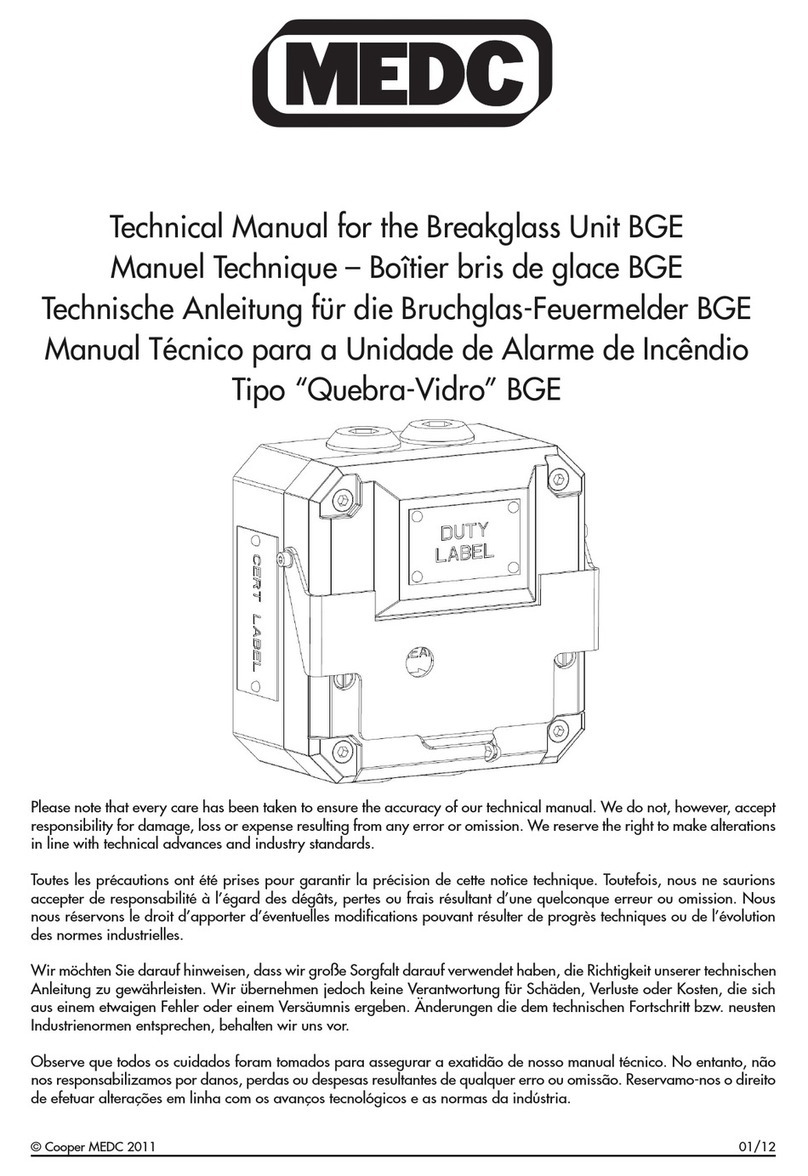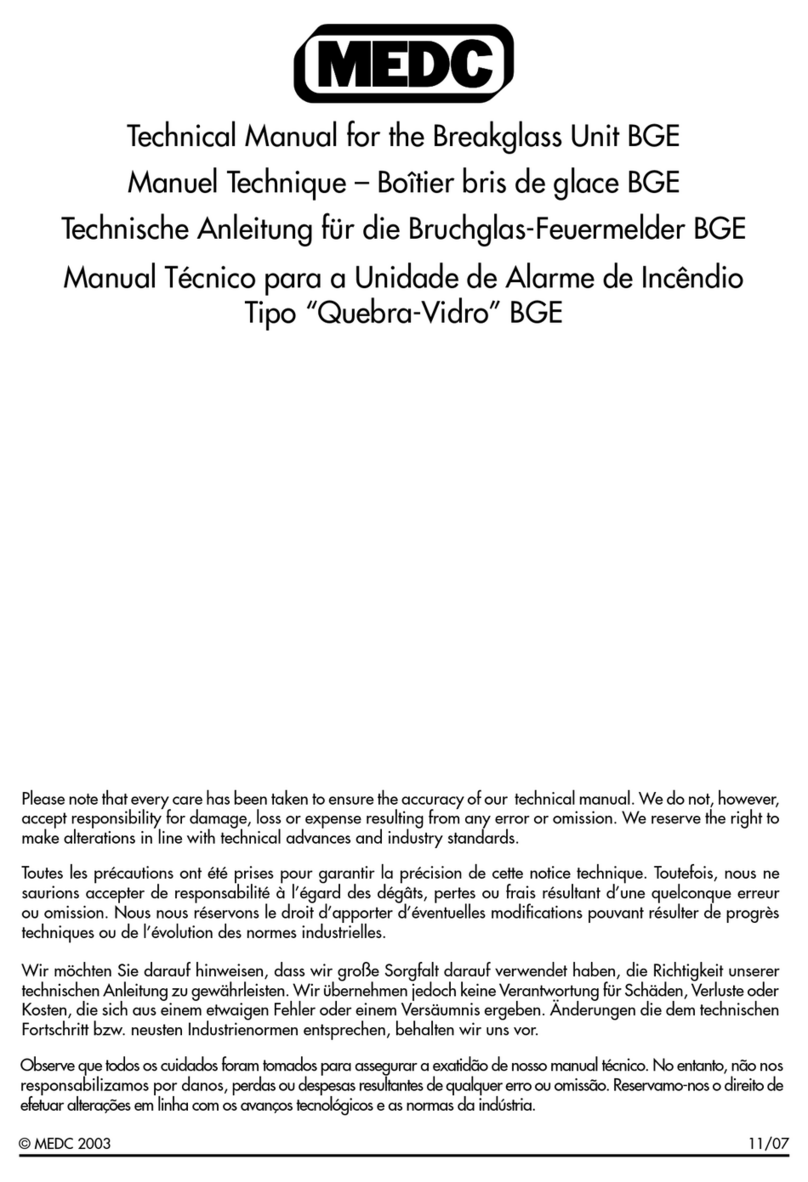rançais
1.0 INTRODUCTION
Le détecte r de chale r HD1 a été conç po r être tilisé dans des atmosphères inflammables et des conditions
environnementales sévères. Le co vercle et le boîtier en alliage de catégorie marine (Exd) o en polyester
renforcé de fibres de verre (versions Exem et Exia) sont adaptés à ne tilisation off-shore o on-shore, où n
poids léger et ne résistance à la corrosion sont nécessaires.
2.0 MESSAGES ET AVERTISSEMENTS GÉNÉRAUX DE SÉCURITÉ
S ivre to tes les instr ctions et messages de séc rité conten s dans ce man el po r permettre l'installation
séc risée de l'appareil. L'appareil doit être excl sivement installé et entreten par d personnel/des
installate rs s r site proprement formés.
i. Po r réd ire le risq e d'incendie dans des atmosphères dangere ses et de décharges, ne pas mettre
l'appareil so s tension avant d'avoir terminer l'installation et avant de l'avoir parfaitement scellé et
séc risé.
ii. Po r réd ire le risq e d'incendie dans des atmosphères dangere ses et de décharges, maintenir
l'appareil totalement fermé lors de la mise so s tension d circ it.
iii. Avant de retirer le co vercle po r to te opération d'installation o d'entretien, s'ass rer q e
l'alimentation de l'appareil est isolée.
iv. Une fois l'installation terminée, tester l'appareil po r s'ass rer de son bon fonctionnement.
v. Une fois l'installation terminée, s'ass rer q ' ne copie de ce man el est mise à la disposition de to s les
opérate rs.
vi. Lors de l'installation de l'appareil, se rapporter a x exigences de sélection, d'installation et de
fonctionnement : a x Réglementations de câblage de l'IEE et a code national d'électricité américain
(NEC) po r l'Amériq e d Nord, par exemple. Des exigences nationales et/o locales
s pplémentaires pe vent également s'appliq er.
vii. Les terminaisons de câble doivent être conformes a x exigences spécifiq es de l'application req ise.
MEDC recommande q e to s les câbles et cond cte rs soient correctement identifiés. Merci de se
rapporter a schéma de câblage fo rni dans ce man el (o a schéma spécifiq e fo rni avec l' nité).
viii. S'ass rer de n' tiliser q e les presses éto pes spécifiées o certifiées, et d bon revêtement et
mise à la terre de l'assemblage.
ix. S'ass rer de n' tiliser q e les bo chons obt rate rs spécifiés o certifiés po r obt rer les entrée de
presses éto pes non tilisées, et q e les normes NEMA/de protection IP de l' nité sont mainten es.
x. MEDC recommande l' tilisation d' ne pâte d'étanchéité telle q e HYLOMAR PL32 s r to s les
filetages des presses éto pes et des bo chons obt rate rs, afin de maintenir les normes de
protection IP de l' nité.
xi. Po r les versions Exem et Exia, ne rondelle d'étanchéité approprié doit être monté s r to tes les
glandes et les bo chons obt rate rs montés dans l'enceinte.
xii. La borne de masse interne, si l' nité en est éq ipée, doit être tilisée po r la mise à la terre de
l'éq ipement, et la borne externe, si disponible, constit e ne fixation s pplémentaire à la borne de
terre lorsq e les normes o a toritées locales permettent o exigent ne telle connexion.
xiii. MEDC recommande l' tilisation d'éléments de fixation en acier inoxydable lors de l'installation de
l'appareil. S'ass rer q e to s les écro s, les bo lons et les fixations sont séc risés.
3.0 INSTALLATION
Le détecte r de chale r se monte via 4 tro s de fixation de 9 mm (version Exd) o 4 tro s de fixation de
7 mm (versions Exem et Exia) sit és s r le socle de l' nité. Les tro s de fixation ont été conç s po r acc eillir
des vis o des bo lons M8 (version Exd) o M6 (versions Exe/Exia). Le détecte r de chale r fonctionne dans
n’importe q elle position.
Retirer/remplacer le couvercle
Version Exd : dévisser et retirer les 4 vis M6 (clé hexagonale/à 6 pans de 5 mm nécessaire) et so lever le
co vercle po r le dégager d socle. Les vis ne sont pas imperdables et doivent être rangées en lie sûr
pendant l'opération de terminaison des câbles.
Version Exem/Exia : dévisser les 4 vis non imperdables M5 (clé hexagonale/à 6 pans de 4 mm nécessaire)
et so lever le co vercle po r le dégager d socle. Les vis d co vercle sont imperdables et ne se dégageront
pas d co vercle.
Une fois l'opération de terminaison des câbles terminée, le co vercle pe t être remis en place et séc risé a
boîtier. S'ass rer q e to s les joints de co vercle sont bien positionnés.
S r les versions Exd, s'ass rer q e l'écart entre le co vercle et le boîtier n'est pas s périe r à 0,15 mm.





























